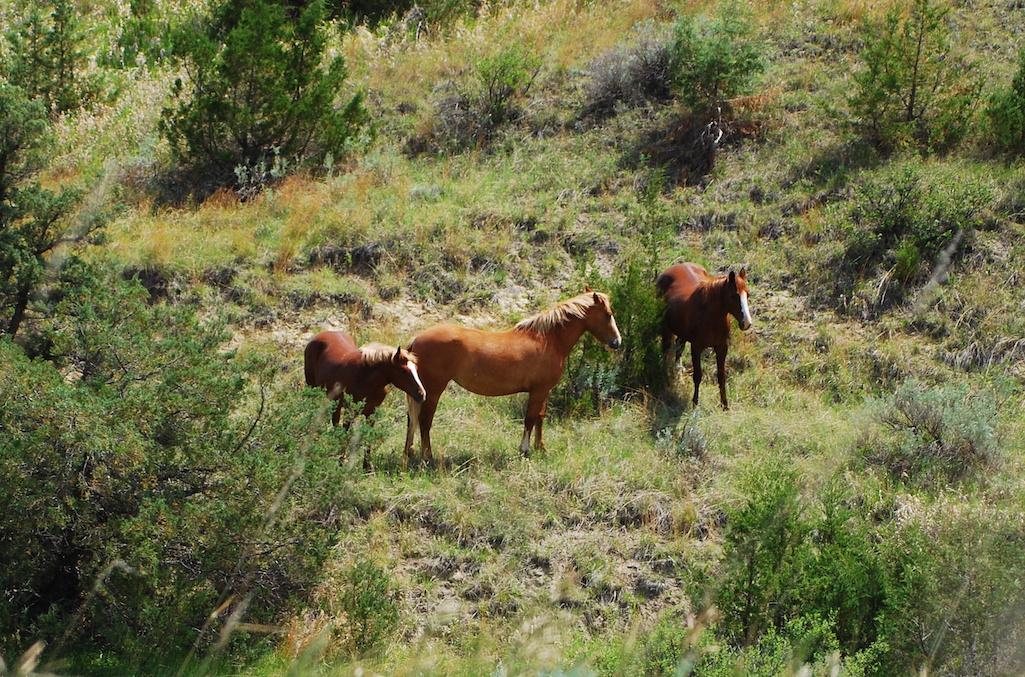
Should feral horses be removed from Theodore Roosevelt National Park?/Kurt Repanshek file
Removing feral horses and cattle from Theodore Roosevelt National Park in North Dakota would benefit native species of wildlife, birds, and vegetation, according to a study concerning how to manage the livestock.
But it's a controversial proposal that generated nearly 20,000 comments during a "scoping period" held to solicit public thoughts on whether the National Park Service should continue to manage the roughly 200 horses and a small handful of longhorn cattle or remove them from the park.
The park hasn't updated its horse management plan since 1978, and its cattle management plan dates to 1970. At issue is whether there should be any change in how the livestock are managed, whether the horses that roam the South Unit and the cattle in the North Unit should be removed as soon as possible, or whether the cattle should be removed and the horse herd reduced in number to a number of "fully contracepted horses" that would be allowed to live out their lives in the park.
The environmental assessment that followed the scoping period and which is open for public comment through October 25 does not contain a preferred alternative, but it does point out the negative impacts the horses have on the landscape and native species such as bison, elk, bighorn sheep, meadowlarks and sharp-tailed grouse, among others.
"Horses and cattle are nonnative species that trample vegetation and compact soil, causing adverse effects on habitat composition and quality," reads a section of the EA. "Horse and cattle herds also compete with native wildlife species, such as elk, deer, bighorn sheep, and bison, for food and water resources. Changing climate conditions may further limit available resources, making competition more severe and limiting the resource capacity for native species in the Park."
Through the decades the Park Service has taken differing approaches to the livestock, as it describes the feral horses and longhorn cattle.
"... the intention of the NPS at Park inception was to remove livestock from the Park in order to recreate a more natural environment reflective of Theodore Roosevelt’s conservation ethos, and removal actions for livestock were therefore actively pursued into the 1960s," the EA states. "While the Park’s horses and cattle have been maintained as demonstration herds since the 1970s, conservation principles and practices have evolved since that time to reflect a more up-to-date scientific understanding of wildlife biology and landscape ecology. Current NPS and Park priorities are to manage the species, resources, and ecosystems that are native to the Park’s landscape."
While those who want horses to remain in the park view them as vestiges of the West that Roosevelt explored in the late 19th century, the EA points out that genetic testing "indicates that the horses in the Park today show no clear ancestral relationship to any one breed, but have the strongest genetic influence from draft breeds and not horses of Spanish origin."
Regarding the longhorn cattle that roam the park's North Unit, the Park Service has pointed out that cattle contract Mycoplasma bovis, a bacterial disease that can be deadly to bison, and that's one reason that would justify their removal.
Comments on the EA will guide the final Park Service decision on how to manage the horses and cattle at Theodore Roosevelt. The EA can be found at this website, where comments can be left.



Comments
With just 200 horse's on park land that haven't been managed since 78 I say leave them. The herd is small and hasn't changed the environment drastically. What they do bring are the visitors who support the.park.
Where else can you see "wild horses"? To me they are wildlife and a delight when you get to see them. If there are too many, yes, they interfere with other native grazers, but too few and they will lack the necessary genetic diversity to survive. I say find the right number and otherwise leave them alone. As for longhorn cattle, really? I see no reason for them to be there, and they can be seen many other places. If they are a true danger (not just speculative) I would say sell them off to somebody.
Any studies to support a claim that folks visit TR NP to view feral horses?
Horses and cattle compact the soil? Bison much bigger and hea ier, dont they compa t the soil? Soil compTion should not be a criteria.